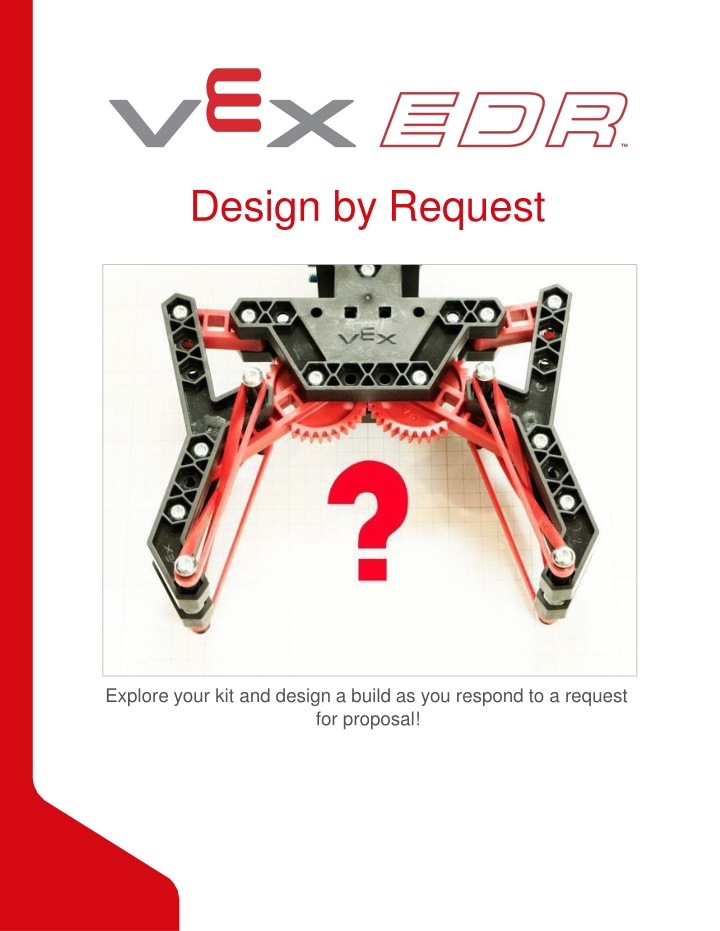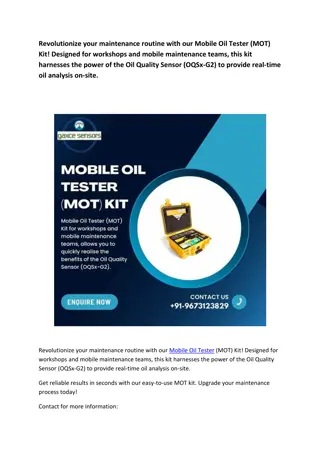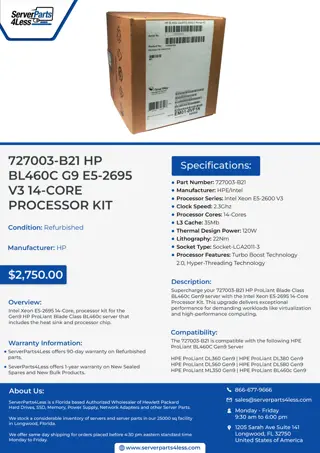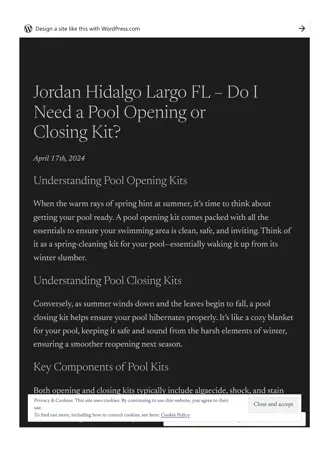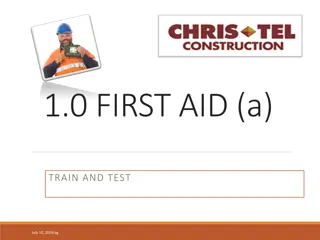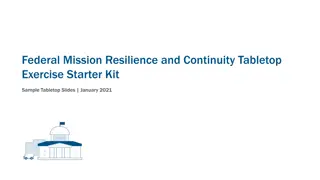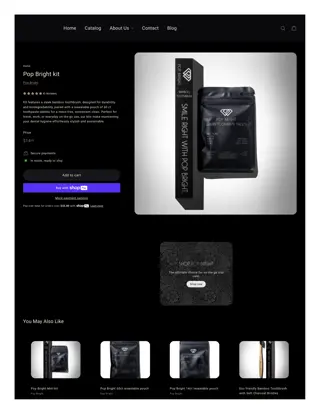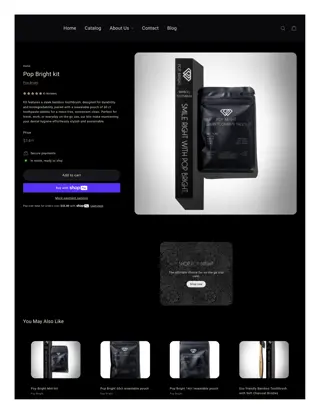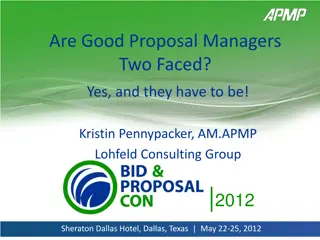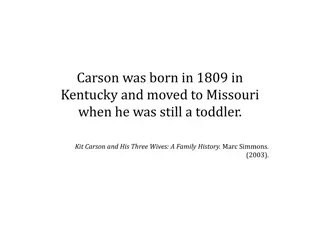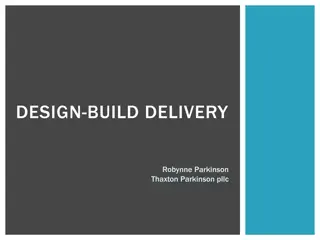Innovative Kit Exploration and Design Build Proposal
Engage in hands-on builds and programming opportunities using a design kit to respond to requests for proposals. Understand the significance of Requests for Proposal (RFPs), how to organize proposals effectively, maintain detailed engineering notebooks, and plan through pseudocode and flowcharts. Explore the kit components, envision potential builds, sketch designs, and articulate how each build can be utilized to address various needs.
Download Presentation

Please find below an Image/Link to download the presentation.
The content on the website is provided AS IS for your information and personal use only. It may not be sold, licensed, or shared on other websites without obtaining consent from the author.If you encounter any issues during the download, it is possible that the publisher has removed the file from their server.
You are allowed to download the files provided on this website for personal or commercial use, subject to the condition that they are used lawfully. All files are the property of their respective owners.
The content on the website is provided AS IS for your information and personal use only. It may not be sold, licensed, or shared on other websites without obtaining consent from the author.
E N D
Presentation Transcript
Design by Request Explore your kit and design a build as you respond to a request for proposal!
Discover new hands-on builds and programming opportunities to further your understanding of a subject matter.
What is a Request For Proposal (RFP)? Student sketching ideas for a Request for Proposal Request For Proposal (RFP) A RFP is a document created to ask interested organizations to submit a plan to solve a problem. These plans are then used by the requesting company to decide which organization is best suited to complete the task. A RFP is composed of the following three major pieces: A summary of RFP's objective Information on the company that is requesting the proposed work Detailed information about what is being requested The detailed information contains the following: A timeline for the project including when it will start Information about the cost of the given proposal
Extra requests that are not required but would be good additions to the project Suggestion of how the proposal should be organized
Engineering Notebooks Alexander Graham Bell's notebook entry from a successful experiment with his first telephone An Engineering Notebook Documents your Work Not only do you use an engineering notebook to organize and document your work, it is also a place to reflect on activities and projects. When working in a team, each team member will maintain their own journal to help with collaboration. Your engineering notebook should have the following: An entry for each day or session that you worked on the solution Entries that are chronological, with each entry dated Clear, neat, and concise writing and organization Labels so that a reader understands all of your notes and how they fit into your iterative design process An entry might include: Brainstorming ideas Sketches or pictures of prototypes
Pseudocode and flowcharts for planning Any worked calculations or algorithms used Answers to guiding questions Notes about observations and/or conducted tests Notes about and reflections on your different iterations
Explore Your Kit Before building, explore the pieces in your kit and respond to the prompts below in your engineering notebook. After reviewing the pieces in your kit, list some builds that you believe you could accomplish with your kit. What are some of the builds that could be built? Sketch detailed designs of the builds you listed above. How might each of the builds you designed above be used? Explain with details and sketches.
Test your build, observe how it functions, and fuel your logic and reasoning skills through imaginative, creative play.
Object Manipulation A robotic arm designed to manipulate objects in outer space Object Manipulation Overview All robots are designed with a purpose in mind, and these purposes can vary greatly. Robots are traditionally used for tasks that would be unsuitable for a human to do, mainly because these tasks are dangerous or inaccessible to humans. Dangerous tasks like bomb disposal or handling hazardous waste, as well as inaccessible tasks such as interplanetary exploration are all perfectly suited to robots. To fulfill their purposes, many robots are required to interact with their environment, and the world around them. Sometimes they are required to move or reorient objects from their environments without direct contact by human operators. The need for object manipulators applies in competition robotics as well. In the typical VEX Robotics Competition, students build a robot to play head-to-head matches against other robots. These games traditionally include some sort of game object that robots must manipulate in such a way that they score points.
Some basic examples of manipulators are: Plows Scoops Friction Grabbers In competition robotics, it is often advantageous to be able to collect multiple game objects at one time. This requires a specific type of object manipulator called an accumulator. An accumulator is a robot mechanism designed to pick up a large number of similar objects. Here are some examples of accumulators: Magazines Conveyor Belts Dumping Hoppers Reversible Hoppers
Become a 21st century problem solver by applying the core skills and concepts you learned to other problems.
Fields of Engineering Engineering is a growing field Fields of Engineering Engineering is both a discipline and a profession that creatively applies scientific theories and mathematical concepts to design, innovate, construct, and organize solutions for a variety of problems that people face. Therefore, engineering is a cornerstone of the STEM movement. As society grows and changes, the need for engineers increases. There are currently over forty types of engineers and those fields keep expanding. Engineers work in many different types of environments such as: Research laboratories Manufacturing sites Construction sites Electrical power plants
Drilling sites Hospitals Car factories Delivery warehouses
Designing a Competition Robot Criteria for quality engineering notebooks Iterative Design of a Competition Robot Competition teams do not just show up at a competition with the first robot that they designed. Teams go through a process to make sure that their best chance of winning is represented on the competition field. To achieve this many teams first create a schedule that fits the team s objectives. After studying the game and its components, teams begin to collaborate and iterate on what they want to include on their robot to maximize points. Those iterations are repeatedly tested and changed as the robot performs the game requirements. This process of designing a product which is tested and evaluated repeatedly at different stages of design is called iterative design. And the iterative design process should be fully documented within the team's engineering notebook. It takes time to get the right design. Designing, building, and testing can be a long process. Mistakes are learning opportunities for teams. Many robots that take the field at their last
competition look nothing like they did at their first. As the team grows and changes, so will the robots look and feel. This learning process is valuable to participants as it gives them a real-life application of the skills they will need to succeed in the future. It is very important for the team to keep track of what was learned, how you incorporated the experience into the next iteration, and the effects of the enhancements that the team made all within the engineering notebook. The image on this page is a list of criteria for quality engineering notebooks. You can see how detailed and organized an engineering notebook should be in order to be considered complete or even outstanding. VEX Robotics Competitions include a Design Award that requires that teams submit their engineering notebooks so that the judges can review the quality of their work and the process(es) they went through to reach their final robot designs.
Is there a more efficient way to come to the same conclusion? Take what you ve learned and try to improve it.
Prepare for the Varied Object Challenge An open V5 Claw Prepare for the RFP Varied Object Challenge In this challenge you will be given a Request For Proposal (RFP) that will require you to build or edit a robot to do as many tasks as it can in a variety of challenges. You will then respond to the RFP with a proposed solution to some or all of the tasks. To complete this challenge you will need the following: V5 Classroom Super Kit A meter stick Objects that the robot can grab (cones, bean bags, erasers, markers, cubes, etc.)
Engineering notebook A box or bin for the objects to be placed
Design Your Build Answer the following questions in your engineering notebook as you design your build. What do you want the build to do? Explain specific actions. How do you plan on testing your build? Explain with details. What will you do to ensure your build is capable of completing the desired task(s)? Explain with details. Test and iterate on your build. What were some things you discovered in your testing that you did not expect? Explain with details. How did you improve your build based on your test results? Explain with details. Is there a change you would like to make but need additional pieces? Explain with details and/or sketches.
Varied Object Challenge RFP A variety of objects meant to be picked up, hung up, or pushed to an area Yost Objects Yesterday Inc. - RFP Review the Motion and Structure tabbed sections within the listing of Kit Contents. YOY Inc. is a family owned business located in Western Pennsylvania specializing in storage. They are capable of storing objects in a variety of orientations, including hanging. Until recently, they have worked without the assistance of robots, but are looking to double their business. YOY has recently purchased a new storage facility but does not have the staff to keep up with demand. They are looking to improve their new warehouse by incorporating a robot. YOY is offering a 3-year contract to develop a robot capable of pushing or grabbing a variety of different shaped objects from the ground and moving them to a storage location. In addition, the robot should be able to grab objects that are hanging and deliver them to a box across the room. The ground objects come in a variety of sizes and shapes. The hanging objects are hung around 60cm from the floor. There is a storage box in the corner of the
room that has an opening 30cm off the ground and a 10cm area around the storage box where objects can be pushed. The project will need to start as soon as possible, and the winning company should deliver the proven robot within a time period set by your facilitator. The materials allowed for the building of the robot for this challenge will include one V5 Classroom Super Kit. This proposal should include the following items: A sketch of the final robot A demonstration of the robot accomplishing this task A description of what the robot will accomplish A timeline for the project
Understand the core concepts and how to apply them to different situations. This review process will fuel motivation to learn.
Review 1. A request for a proposal (RFP) is a: An advertisement for a new product. o Document created to ask interested organizations to submit a plan to solve a problem. o Document created to give a organizations directions in how to complete a project. o Document created to ask interested organizations to submit their cost to complete the project. o 2. An RFP is composed of three major pieces, except: Summary of what the RFP is looking for. o Information on the company that is requesting the proposed work. o Detailed information about what is being requested. o The names of the team members that will be completing the work. o 3. The object. 's most common form is a claw which pinches an Top-Jaw Grabber o Friction Grabber o Scoop o Plow o 4. A applies force underneath an object such that the object can be elevated and carried. Top-Jaw Grabber o Friction Grabber o Scoop o All the answers are correct. o
5. are manipulators that apply force to the side of an object. Top-Jaw Grabbers o Friction Grabbers o Scoops o Plows o 6. Engineers work to solve problems through . design and innovation o construction and organization o applying scientific theories o All the answers are correct o 7. True or False: Engineering is both a discipline and a profession. True o False o 8. True or False: When working in a team, each team member will contribute to the same journal to maintain a consistent workflow. True o False o 9. True or False: You use an engineering notebook to organize and document your work. True o False o 10.The detailed information in a RFP contains the following: Information about the cost of the given proposal. o All the answers are correct. o Suggestion of how the proposal should be organized. o A timeline for the project including when it will start. o
Scoop Manipulators A robot manipulating a ball using a scoop Scoop Manipulators Scoop manipulators apply force underneath an object such that the object can be elevated and carried.
Plow Manipulators A plow pushingballs Plow Manipulators Plows are a type of manipulator that apply force to the side of an object. They move objects without actually picking them up.
Friction Grabber Manipulators A claw holding and object using frictional force Friction Grabber Manipulators Friction grabber manipulators apply force between an object and a pad, and then rely on the frictional force between the object and pad to manipulate the object. The most common form of this manipulator is a claw which pinches an object. The claw pressing against the object provides the force, and the friction between the claw and the object allows for the object to be manipulated.
Magazine Accumulators A magazine accumulator collecting balls Magazine Accumulators A magazine accumulator loads one object at a time into some sort of storage area and holds in a fixed orientation, in line (i.e. the first object in is the last object out). In this type of accumulator, the objects are typically not actively manipulated once they are inside the storage area.
Conveyor Belt Accumulator A non-indexing conveyor belt accumulator collecting balls Conveyor Belt Accumulators A conveyor belt accumulator uses some sort of belt to manipulate the objects even after they have been collected into the robot. Conveyor belts are a type of frictional grabbers since they rely on the friction between the belt and object to accumulate. It is important to note that there are two main types of conveyor belts: indexing belts, in which the belt runs only when grabbing an object to enable good sorting, and non-indexing belts in which the belt continuously runs and the objects self-sort. A non-indexing conveyor belt as shown above continuously runs. When the first object is grabbed it moves to the top of the belt until it hits the back of the accumulator where it hits a stop and the belts slide past it. When a second object is grabbed it moves up until it hits the first, and stops (at which point the belt now slides past both of these stationary objects).
Dumping Hopper Accumulators A robot collecting objects into a dumping hopper accumulator Dumping Hopper Accumulators A hopper is a large storage area in which objects are placed. With dumping hoppers, the way objects are released is different than the way they are gathered. On this robot a claw arm picks up objects and dumps them into the hopper, then the hopper tilts back like a dump truck to score the objects in a goal.
Reversible Hopper Accumulator A robot collecting balls using a reversible hopper accumulator Reversible Hopper Manipulators A hopper is a large storage area in which objects are placed. With dumping hoppers, the way objects are released is different than the way they are gathered. Reversible hoppers release objects through the same mechanism that gathers them. In the accumulator above, the objects are sucked into a large bin by two rollers. To score them the robot simply reverses the rollers and pushes the objects back out.
Using the 1 Post Hex Nut Retainer w/ Bearing Flat 1 Post Hex Nut Retainer w/ Bearing Flat Using the 1 Post Hex Nut Retainer w/ Bearing Flat The 1 Post Hex Nut Retainer w/ Bearing Flat allows shafts to spin smoothly through holes in structural components. When mounted, it provides two points of contact on structural components for stability. One end of the retainer contains a post sized to securely fit in the square hole of a structural component. The center hole of the retainer is sized and slotted to securely fit a hex nut, allowing a 8-32 screw to easily be tightened without the need for a wrench or pliers. The hole on the end of the Retainer is intended for shafts or screws to pass through. To make use of the retainer: Align it on a VEX structural component such that the end hole is in the desired location, and the center and end sections are also backed by the structural component.
Insert the square post extruding from the retainer into the structural component to help keep it in place. Insert a hex nut into the center section of the retainer so that it is flush with the rest of the component. Align any additional structural components to the back of the main structural component, if applicable. Use an 8-32 screw of appropriate length to secure the structural component(s) to the retainer through the center hole and hex nut.
Using the 4 Post Hex Nut Retainer 4 Post Hex Nut Retainer Using the 4 Post Hex Nut Retainer The 4 Post Hex Nut Retainer provides five points of contact for creating a strong connection between two structural components using one screw and nut. Each corner of the retainer contains a post sized to securely fit in a square hole within a structural component. The center of the retainer is sized and slotted to securely fit a hex nut, allowing a 8-32 screw to easily be tightened without the need for a wrench or pliers. To make use of the retainer: Align it on a VEX structural component such that the center hole is in the desired location, and each corner is also backed by the structural component. Insert the square posts extruding from the retainer into the structural component to help keep it in place. Insert a hex nut into the center section of the retainer so that it is flush with the rest of the component.
Align any additional structural components to the back of the main structural component, if applicable. Use an 8-32 screw of appropriate length to secure the structural component(s) to the retainer through the center hole and hex nut.
Using the 1 Post Hex Nut Retainer 1 Post Hex Nut Retainer Using the 1 Post Hex Nut Retainer The 1 Post Hex Nut Retainer provides two points of contact for connecting a structural component to another piece using one screw and nut. One end of the retainer contains a post sized to securely fit in the square hole of a structural component. The other end of the retainer is sized and slotted to securely fit a hex nut, allowing a 8-32 screw to easily be tightened without the need for a wrench or pliers. To make use of the retainer: Align it on a VEX structural component such that both ends are backed by the structural component and positioned to secure the second piece. Insert the square post extruding from the retainer into the structural component to help keep it in place. If the retainer is being used to secure two structural components, insert a hex nut into the other end of the retainer so that it is flush with the rest of the component. If used to secure
a different type of component, such as a standoff, it may be appropriate to insert the screw through this side. Align any additional components to the back of the main structural component, if applicable. If the retainer is being used to connect two structural components, use an 8-32 screw of appropriate length to secure the structural components through the hole and hex nut. If used to connect a different type of component, such as a standoff, secure it directly or with a hex nut.
